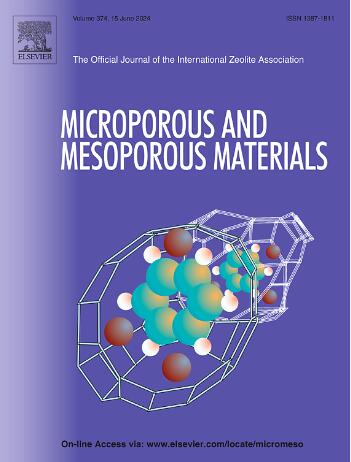调整PCP-SAFT状态方程,以估计纯流体和混合物在有序介孔二氧化硅中的吸附-解吸滞后
IF 4.7
3区 材料科学
Q1 CHEMISTRY, APPLIED
引用次数: 0
摘要
本研究通过调整微扰链极性统计关联流体理论(PCP-SAFT)状态方程的分散能参数,建立了预测纳米多孔材料中纯组分和混合物的毛细管凝聚蒸发滞后的综合模型。该模型基于一个广泛的迟滞数据集,该数据集包含24个不同分量的304个数据点,包括非极性、极性和相关分量。确定了吸附和解吸过程的分散能参数,并提出了新的关联关系,以提高毛细冷凝和蒸发压力预测的准确性。结果表明,该模型具有较好的预测精度,对纯组分的毛细冷凝压力和蒸发压力的平均绝对相对偏差(AARD)分别为10.89%和10.95%。研究还考察了孔径、温度和流体相互作用对毛细管冷凝蒸发滞后的影响。在不同温度和孔径条件下,该模型与纯组分和混合组分的实验数据吻合良好。研究结果强调了孔隙大小和温度在决定迟滞程度方面的关键作用。在特定孔径下,特别是在吸附剂平均孔径半径与PCP-SAFT段尺寸之比(rp/σ)为15-17时,以及在较低温度下,观察到较强的滞后性。研究表明,该模型为预测纳米多孔材料的毛细管冷凝蒸发行为提供了可靠的框架,在气体储存、分离过程和环境应用等各个领域具有潜在的应用前景。本文章由计算机程序翻译,如有差异,请以英文原文为准。

Tuning the PCP-SAFT equation of state to estimate adsorption-desorption hysteresis of pure fluids and mixtures confined in ordered mesoporous silica
This study presents a comprehensive model for predicting the capillary condensation-evaporation hysteresis of pure components and mixtures in nanoporous materials, by tuning the dispersion energy parameter of the perturbed-chain polar statistical associating fluid theory (PCP-SAFT) equation of state. The model is based on an extensive hysteresis dataset comprising 304 data points for 24 different components, including nonpolar, polar, and associating components. The dispersion energy parameters for both adsorption and desorption processes are determined, and new correlations are proposed to improve the accuracy of the capillary condensation and evaporation pressure predictions. The results indicate that the current model provides superior prediction accuracy, with average absolute relative deviation (AARD) values of 10.89 % for the capillary condensation pressure and 10.95 % for evaporation pressure in pure components. The study also examines the effects of pore size, temperature, and fluid interactions on the capillary condensation-evaporation hysteresis. The model demonstrates good agreement with experimental data for both pure components and mixtures, under varying temperatures and pore sizes. The findings highlight the critical role of pore size and temperature in determining the extent of hysteresis. Stronger hysteresis is observed at specific pore diameters, particularly around a ratio of the sorbent mean pore radius to the PCP-SAFT segment size (rp/σ) of 15–17, and at lower temperatures. The study concludes that the model provides a reliable framework for predicting the capillary condensation-evaporation behavior in nanoporous materials, with potential applications in various fields such as gas storage, separation processes, and environmental applications.
求助全文
通过发布文献求助,成功后即可免费获取论文全文。
去求助
来源期刊

Microporous and Mesoporous Materials
化学-材料科学:综合
CiteScore
10.70
自引率
5.80%
发文量
649
审稿时长
26 days
期刊介绍:
Microporous and Mesoporous Materials covers novel and significant aspects of porous solids classified as either microporous (pore size up to 2 nm) or mesoporous (pore size 2 to 50 nm). The porosity should have a specific impact on the material properties or application. Typical examples are zeolites and zeolite-like materials, pillared materials, clathrasils and clathrates, carbon molecular sieves, ordered mesoporous materials, organic/inorganic porous hybrid materials, or porous metal oxides. Both natural and synthetic porous materials are within the scope of the journal.
Topics which are particularly of interest include:
All aspects of natural microporous and mesoporous solids
The synthesis of crystalline or amorphous porous materials
The physico-chemical characterization of microporous and mesoporous solids, especially spectroscopic and microscopic
The modification of microporous and mesoporous solids, for example by ion exchange or solid-state reactions
All topics related to diffusion of mobile species in the pores of microporous and mesoporous materials
Adsorption (and other separation techniques) using microporous or mesoporous adsorbents
Catalysis by microporous and mesoporous materials
Host/guest interactions
Theoretical chemistry and modelling of host/guest interactions
All topics related to the application of microporous and mesoporous materials in industrial catalysis, separation technology, environmental protection, electrochemistry, membranes, sensors, optical devices, etc.
 求助内容:
求助内容: 应助结果提醒方式:
应助结果提醒方式:


